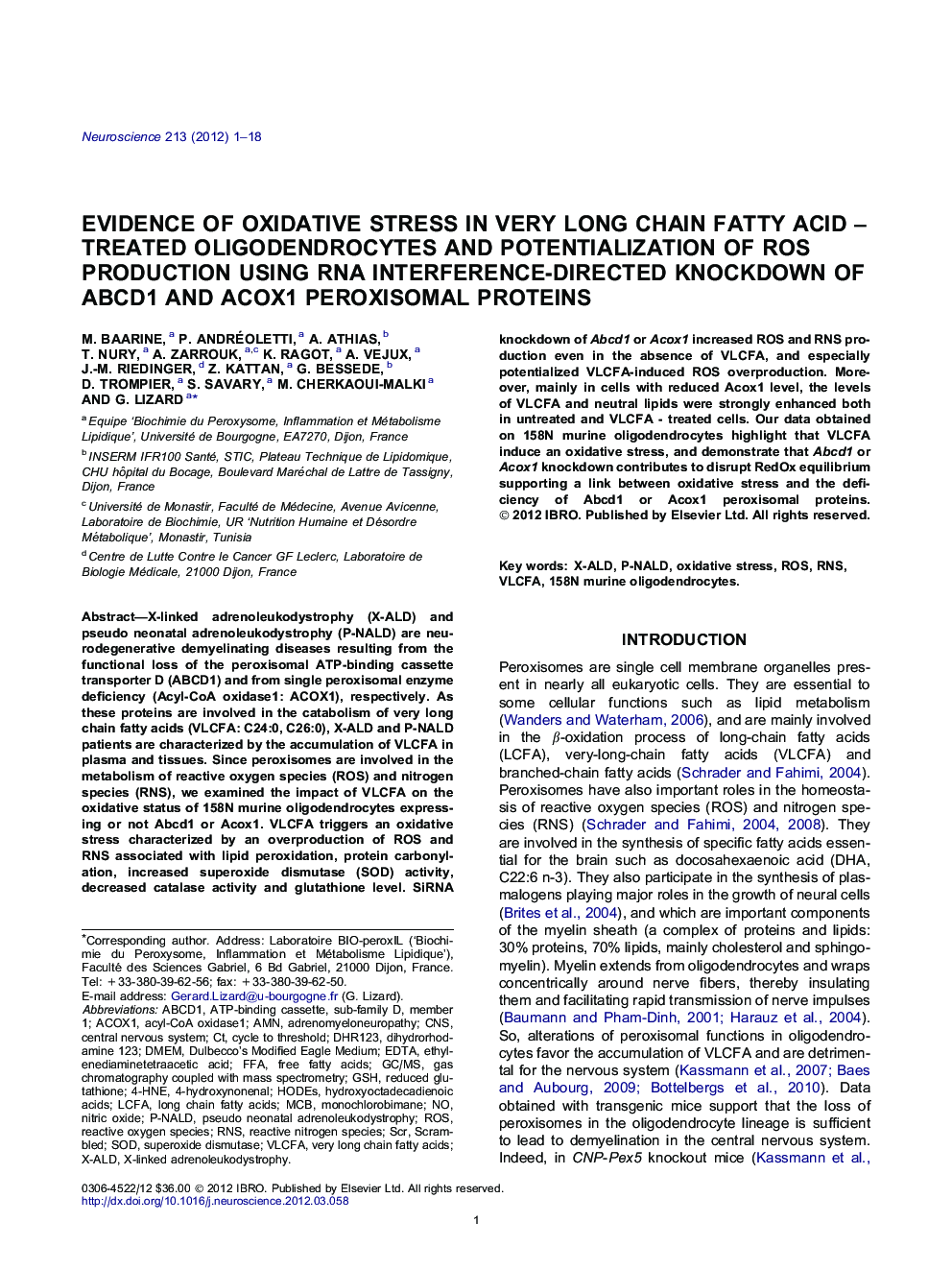| Article ID | Journal | Published Year | Pages | File Type |
|---|---|---|---|---|
| 4338448 | Neuroscience | 2012 | 18 Pages |
X-linked adrenoleukodystrophy (X-ALD) and pseudo neonatal adrenoleukodystrophy (P-NALD) are neurodegenerative demyelinating diseases resulting from the functional loss of the peroxisomal ATP-binding cassette transporter D (ABCD1) and from single peroxisomal enzyme deficiency (Acyl-CoA oxidase1: ACOX1), respectively. As these proteins are involved in the catabolism of very long chain fatty acids (VLCFA: C24:0, C26:0), X-ALD and P-NALD patients are characterized by the accumulation of VLCFA in plasma and tissues. Since peroxisomes are involved in the metabolism of reactive oxygen species (ROS) and nitrogen species (RNS), we examined the impact of VLCFA on the oxidative status of 158N murine oligodendrocytes expressing or not Abcd1 or Acox1. VLCFA triggers an oxidative stress characterized by an overproduction of ROS and RNS associated with lipid peroxidation, protein carbonylation, increased superoxide dismutase (SOD) activity, decreased catalase activity and glutathione level. SiRNA knockdown of Abcd1 or Acox1 increased ROS and RNS production even in the absence of VLCFA, and especially potentialized VLCFA-induced ROS overproduction. Moreover, mainly in cells with reduced Acox1 level, the levels of VLCFA and neutral lipids were strongly enhanced both in untreated and VLCFA - treated cells. Our data obtained on 158N murine oligodendrocytes highlight that VLCFA induce an oxidative stress, and demonstrate that Abcd1 or Acox1 knockdown contributes to disrupt RedOx equilibrium supporting a link between oxidative stress and the deficiency of Abcd1 or Acox1 peroxisomal proteins.
Graphical abstractMurine oligodendrocytes (158N) transfected with scrambled (Scr) siRNA or with siRNA against Abcd1 or Acox1 were further cultured for 24 h in the absence (control) or in the presence of α-cyclodextrin (vehicle: 1 mg/mL) or VLCFA (C24:0 or C26:0: 5, 10, 20 μM). The intracellular production of superoxide anion (O2-) (A), hydrogen peroxide (H2O2) (B), and nitric oxide (NO) (C) were measured by flow cytometry with DHE, DHR123, and DAF-FM, respectively. The dark horizontal dotted lines represent the threshold of control cells. Data shown are mean ± SD from three independent experiments performed in triplicate. Significance of the difference between control (untransfected and untreated 158N cells) and untransfected 158N cells treated with vehicle, C24:0 and C26:0 (Mann Whitney test; ∗P < 0.05 or less). Significance of the differences between transfected versus untransfected cells (Mann-Withney test, #P < 0.05 or less). Significance of the differences between transfected cells without fatty acids versus transfected cells with fatty acids (Mann Withney test, †P < 0.05 or less).Figure optionsDownload full-size imageDownload high-quality image (115 K)Download as PowerPoint slideHighlights► VLCFA induce an overproduction of ROS and RNS on murine oligodendrocytes. ► Abcd1 or Acox1 knockdown is sufficient to disrupt RedOx equilibrium. ► Abcd1 and Acox1 knockdown potentialize VLCFA – induced ROS overproduction. ► Potential link between VLCFA, Abcd1 or Acox1 deficiency and oxidative stress.
